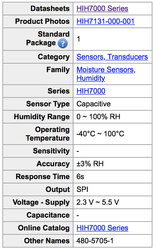Goals
Time to set your goals! What do you want out of your hardware? Did you find a cool chip or sensor that does what you want and you need a supporting cast? Or do you want to sense the CO2 content? How fast your bike is? Are you trying to build a weather station for your roof? A USB light?
Once you have chosen your goal, you should access the plausibility. Do some preliminary research of what chips you will be using. For example, if you are building a weather station, let's say you want to track location, humidity, altitude, wind speed, etc. Find sensor for each and how they will interact with each other.
For humidity, you may find the HIH7130. If you scroll down, to the bottom of Digikey's page, you will see some information.
Once you have chosen your goal, you should access the plausibility. Do some preliminary research of what chips you will be using. For example, if you are building a weather station, let's say you want to track location, humidity, altitude, wind speed, etc. Find sensor for each and how they will interact with each other.
For humidity, you may find the HIH7130. If you scroll down, to the bottom of Digikey's page, you will see some information.
The information includes how the humidity is sensed (capacitively), the humidity range (0 -100% relative humidity), the operating temperature (-40 to 100C), the humidity accuracy (3%), the time to get a measurement (6 seconds), how to get the data off the chip (SPI), and the DC voltage supply required. The humidity range, accuracy, operating temperature, and response time are critical pieces of information for your application. For example, if this sensor is going to be placed on a model rocket going 100 m/s, you can only get humidity readings every 600 meters. Does this fit your application? Only you know the answer!
The SPI communications and DC voltage supply will be more important later, but you can ignore them for now!
Keep in mind this is still the exploratory phase so details are not important as long as you know that your sensors or motors or LEDs or whatever the purpose of the circuit board meets your goals! After settling down on your critical chips, we can move to the block diagram.
The SPI communications and DC voltage supply will be more important later, but you can ignore them for now!
Keep in mind this is still the exploratory phase so details are not important as long as you know that your sensors or motors or LEDs or whatever the purpose of the circuit board meets your goals! After settling down on your critical chips, we can move to the block diagram.

